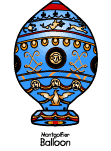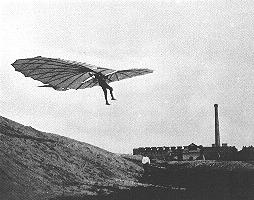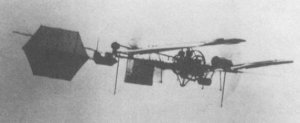
Before Wilbur en Orville
The Chinese built kites long before Christianity. If they carried people is unknown. Yet, without knowing, the Chinese were on the right track to something that would become an aeroplane in the end. Kites are actual fixed wings that lift because of the wind.
Next, all kinds of inventors and researchers started to look too much at the birds again. People put on strange suits with wings attached and jumped from church towers and other high points. Too often it was the last thing they undertook and they would not live to tell the tale... The famous inventor and painter Leonardo da Vinci designed aeroplanes and about 1480 he drew an "Ornithopter", in which the pilot had to turn wheels, which moved the wings up and down. As far as we know, the apparatus is never built. Well, it would not have flown anyway because it was too heavy.
After Leonardo people built all kinds of curious aeroplanes, but they never flew. In the middle of all the fluttering and bungling the British scientist and bishop John Wilkins attracted attention. In 1648 he wrote that the best thing you could do in order to fly was a step-by-step method.
The Mongolfier brothers were
the first to achieve a success. In 1783 they built a hot air balloon in which
two volunteers travelled from Paris. The flight lasted 25 minutes and they
landed 8 km further down. The balloon had one disadvantage: the wind blew the
balloon forwards and the occupants could not determine the direction because it
was impossible to steer the balloon. A balloon is an example of a flying machine
that is lighter than air.
In 1852 Frenchman Henri Giffard flew a distance of 27 km with a dirigible balloon: an oblong airship provided with a steam engine. He achieved a speed of 10 km/h. This was a lighter than air airship too.
 Most builders of aeroplanes were dreamers, but some of
them took a scientific approach. One of them was the Englishman George Caley,
who was born in 1773 and enthousiastic about the balloon flights in France.
Caley's "Boy Glider" was very close to an aeroplane. It could glide,
but the flights covered only about a few meters with a ten-year old boy on board.
Cayley made aviation a serious matter and that was very important. After Cayley
others went further with his experiences.
Most builders of aeroplanes were dreamers, but some of
them took a scientific approach. One of them was the Englishman George Caley,
who was born in 1773 and enthousiastic about the balloon flights in France.
Caley's "Boy Glider" was very close to an aeroplane. It could glide,
but the flights covered only about a few meters with a ten-year old boy on board.
Cayley made aviation a serious matter and that was very important. After Cayley
others went further with his experiences.
The Englishman Henson designed a flying "steam-coach", but steam-engines were far too havy for an aeroplane. Frenchman Clément Ader used a steam engine too but did not achieve more than some little hops off the ground. This, one could not call flying.
The American Hiram Maxim built a lightweight steamengine of 180 hp. He could even lift it himself by hand. But his aeroplane was very heavy too. Consequently, it never flew.
 The
German Otto Lilienthal went about it
differently. He did read the books of John Wilkins well and wanted to know more
about flying step-by-step. He built gliders, in which he was attached in the
middle of the wing. By moving his body, he could steer the plane. The same way
hang glider pilots do nowadays. He built gliders with one and two wings and he learned a lot about the shape of the wings by experimenting.
The
German Otto Lilienthal went about it
differently. He did read the books of John Wilkins well and wanted to know more
about flying step-by-step. He built gliders, in which he was attached in the
middle of the wing. By moving his body, he could steer the plane. The same way
hang glider pilots do nowadays. He built gliders with one and two wings and he learned a lot about the shape of the wings by experimenting.
He glided distances up to 350 meters. In 1896 however, a blast of wind made him
lose control, he crashed and subsequently lost his life. Fortunately, he wrote all his
discoveries down in books.
At the end of the nineteenth century a
lot of people were occupied with gliders because they were convinced that the first thing
to do was learning to glide and after that building an engine in the aeroplane. Those
who put an engine in their aeroplane to hastily, noticed that it was often too
heavy. An aeroplane had to be light and strong. This had not been achieved
until then. Either the aeroplane was too heavy or it broke down already while
taking off.
first thing
to do was learning to glide and after that building an engine in the aeroplane. Those
who put an engine in their aeroplane to hastily, noticed that it was often too
heavy. An aeroplane had to be light and strong. This had not been achieved
until then. Either the aeroplane was too heavy or it broke down already while
taking off.
The last years of the nineteenth century it were the Americans in particular who built aeroplanes. One of them was professor Langley, an astronomer who became very interested in aviation. He started with building a model, provided with a petrol (gasoline) engine. That engine had been invented not long before. (And this engine too was an example of researchers who all together helped to improve something bit by bit).
The models flew almost two minutes and reached distances of more than one kilometre. Control however, was impossible. There were no occupants either.
Below you can see the most important people in a timeline:
